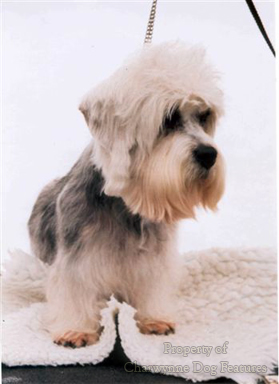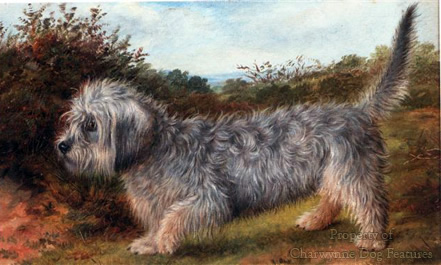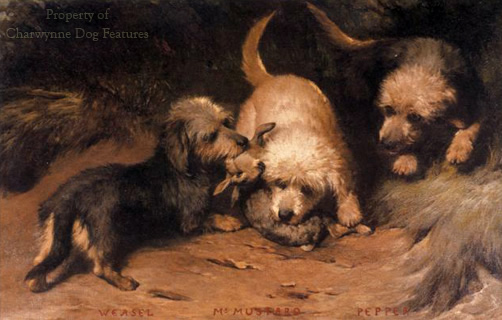690 READING THE DANDIE
READING THE DANDIE
by David Hancock
“That the Dandie is not a taking dog at first sight we admit; and visitors to shows that are unacquainted with the dog often pass very uncomplimentary remarks on the rough tykes that lie dozing on their benches. But see that dark eye flash fire when a rat makes an appearance in the stable, and see the dash he makes for it, you cannot but like the dog if you are a sportsman and admire pluck…Our experience of the breed is that they live for worrying, and think every living thing, from a fox downwards, was born to be worried.”
DJ Thomson Gray FZS in his The Dogs of Scotland, James Mathew, 1891.

Have the terrier breeds of Scotland, like the Dandie Dinmont Terrier, lost their sporting heritage? The West Highland has long been a show ring favourite; the Cairn has a loyal following, with, I understand, at least one working terrier backer; the Skye however could be lost to us within half a century. The Scottie is still very much with us but like the others has no discernible working activity. The Dandie Dinmont has, I believe, a tiny band of working devotees. Do any of these Scottish terrier breeds deserve to retain their sporting terrier tag? Working use apart, have these breeds still retained the anatomy to work? I despair when I hear a show breeder of these worthy and long-established breeds declare that he “doesn’t want his terriers to go to ground, so why get het-up about the ability to do so”. So much for respecting the origins of your breed!
In his contribution to Compton’s The Twentieth Century Dog of 1904, EWH Blagg wrote: “I think at the present time it behoves breeders and exhibitors not to forget that the Dandie Dinmont is a terrier. A great many of the failures of the breeder which are sold cheap as ‘companions’ are clumsy, heavy-looking, crooked-legged dogs, altogether unlike a terrier in appearance, and thus the general public get deluded into the idea that the Dandie ought to have crooked legs, like the dachshund, and that it is not a member of the terrier family.” Blagg was a Dandie breed enthusiast not an anti-pedigree or show ring hostile critic. He was if anything a prophet! Today’s breed is easily confused with a wire-haired Dachshund and its top-knot more valued than its soundness, its bent legs desirable and its thin woolly coat acceptable.
For centuries, Scotland has had small rough-haired terriers of this type, reference being made as far back as 1436 by John Leslie, in his ‘History of Scotland’, to a ‘dog of low height, which, creeping into subterraneous burrows, routs out the foxes, badgers, martens, and wild cats from their lurking places and dens.’ HD Richardson, writing in 1853, refers to three varieties of terriers in Scotland, one ‘sandy-red and rather high on the legs’ and called the Highland Terrier; a second, the same size but ‘with the hair somewhat flowing and much longer, which gives a short appearance to the legs. This is the prevailing breed of the Western Isles of Scotland’; and a third ‘the dog celebrated by Sir Walter Scott as the Pepper and Mustard or Dandie Dinmont breed’. From this account, you could be forgiven for thinking of the Cairn, the Scottie and the Westie as one breed, with the Skye and the Dandie also featuring as distinct breeds at that time.
Two authors, sixty years apart, but both writing on sporting terriers, Pierce O’Conor and Brian Plummer, didn’t write gushingly about terriers from Scotland. On the Dandie, O’Conor wrote “They are now, I fear, little used for work, ‘at the tods and the brocks’, more’s the pity. The show bench Dandie is rather too heavy and too low to the ground for an active working dog.” Plummer wrote of the Dandie “It is in fact a pity that nobody is prepared to exploit the working qualities of the Dandie Dinmont for the type is still ideal for working below ground.” Both these distinguished writers on terriers clearly mourned the loss of such a game little breed from the world of the working terrier. Terrier-man Alf Rhodes of Darton near Barnsley, who died in 2003, was using a Dandie called ‘Cindy’ (born 1973) right up to her eighth birthday; he worked several terrier breeds but swore by her. Yet in the early 1920s Gavin Haddon’s renowned earth-dog and grandson of the famous Yellow Dirk, perpetuating EB Smith’s legendary Blackett House strain, was considered to be the last of the working Dandies.
Terrier authority John Winch, writing in the Fell and Moorland Working Terrier Club magazine, once described the Dandie Dinmont as the ‘crème-de-la-crème’ of working terriers, yet a couple of decades later they are only patronized in the show ring. Does the effeminate-sounding breed title, coming as it does from a fictional sporting squire in one of Scott’s novels, put down-to-earth terrier-men off? This breed was once the choice of sportsmen in the Coquet Valley of Northumberland, where they rarely reached 15lbs weight and were prized for their crisp double-coated jackets. Now, even in the show ring, Dandies are being criticised for the poor quality of their coats, amongst other worries about their construction.
One show report in 2009 stated that “Perhaps, with the profuse furnishings often seen, the jacket has suffered…” Another in the same year gave the view that “we have to thank our American friends for that good function and excellent anatomy now has been so generally established. Restricted movement is becoming rarer and rarer.” Whilst every improvement is welcome in such a breed, it is surely a sad comment on the breed’s custodianship here if the Americans have to ‘right the ship’. A year earlier, one show ring judge reported: “My main concerns were fronts, many were weak in pasterns, thin and open feet (sic) and weak muzzles, which for a working terrier are very bad faults rendering them unable to do the job which they were bred for.” Another show report that year stated that the judge was “disappointed in front movement in too many exhibits but that is nothing new for the breed. But I was also disappointed that some were not good in hind movement either.” For a sporting terrier breed to attract such comments is depressing.
The ‘book’ of the Dandie Dinmont Terrier urgently needs to be re-read; any second reading of the Dandie’s history will surely direct any future breed fancier to a more honourable path than that taken in the past century. It is not difficult to breed dogs; it is another matter entirely to breed sporting dogs. Gough and Thomas list this breed as being predisposed to intervertebral disc disease, refractory corneal ulceration in older dogs and glaucoma; hypochondroplasia is an accepted physiological condition, as it is in most short-legged breeds. Hip dysplasia and medial sub-luxation of the patella are sometimes reported in the breed. But small terriers should not ‘hop’! The breeder’s aim must be to produce dogs with stable joints, sound movement and legs that look and move straight both fore and aft. If an outcross is needed, I would look at an unrelated extremely sound minor breed like the Basset Fauve de Bretagne or Chestnut Basset of Brittany. With a dense harsh flat coat and a withers height of 12 to 15 inches, against the Dandie’s 8-11 inches, such an infusion of fresh blood would add a little more height on the leg, quite apart from improving the coefficient of inbreeding in Dandies. But of course, pure-breeding is today more important than healthy breeding, so it will never happen. How differently our ancestors thought when developing these fine breeds for us to knowingly spoil a century or two later.
The Kennel Club is at last striving to ensure that each breed recognized by them is bred and shown with due regard to its original function; that’s a good start, every sporting terrier breed has to be just that. There are moves too to link the breed once again with its place of origin, which will lead to greater respect for its roots. But until a patriotic Scottish or loyal Borders terrier-man actually uses them in the field, the vital link between function and form may prove elusive. For terrier-men, form will always come second to function, usefulness forever rated higher than handsomeness. But the two are not mutually-exclusive, I see lots of cosmetically-appealing working terriers at country shows; they are good-looking but they are also looking for work. If the old Dandie spirit can be reawakened and the working anatomy restored, then an important breed title could be reclaimed for our sporting terrier lists. In the end it will be a matter of how much the breed fanciers in this attractive ancient breed want to honour their breed’s past and respect its origins. It would so good to find this breed in safer hands.